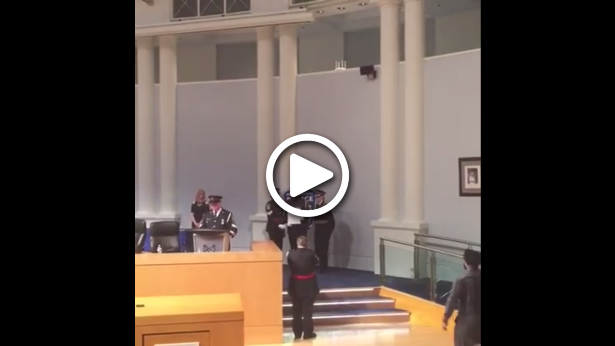Sikh students teach their teachers about their Faith in Montgomery, US
Hana Kaur Mangat looked out at her students, wondering which one she should call on. “Anyone have any questions?” she asked in a perfect educator’s mix of prim and peppy. “If not, I’ll just keep asking questions. I have lots of questions to ask.” Hana, 17 years old and totally poised in a red scarf […]
Hana Kaur Mangat looked out at her students, wondering which one she should call on. “Anyone have any questions?” she asked in a perfect educator’s mix of prim and peppy. “If not, I’ll just keep asking questions. I have lots of questions to ask.”
Hana, 17 years old and totally poised in a red scarf and bold glasses, stood before an audience of adults who all work as teachers in the Montgomery County Public Schools.
The students have been teaching a sort of Sikhism 101 to their teachers at after-school events at their gurdwara — a Sikh house of worship — in North Potomac for four years. Last year, according to organizer Harminder Kaur, they won approval from the state of Maryland to get their free class to count as formal teacher training.
Now they’re planning classes for educators from across the state and from the District. Next, the students want to go national: They’re training groups of kids at gurdwaras in Fresno, Calif., and Phoenix to implement the same program for their own teachers.
Sikh rappers, Sikh basketball players, Sikh YouTubers, Sikh holidays, Sikh prayer — the class in Montgomery covered everything that the Sikh students know all about — and most of their teachers don’t.
There are 25 million Sikhs worldwide, compared to just 14 million Jews, according to the World Religion Database. Yet in America, where at least 360,000 Sikhs belong to 246 congregations, the majority of citizens know nothing about Sikhism — 60 percent of Americans, according to a recent study commissioned by the new National Sikh Campaign, say they don’t know anything at all about the religion.
Americans incorrectly assume, by large majorities, that a person wearing a turban — symbolic of Sikh faith — is Muslim. Two-thirds of Americans say they’ve never interacted with anyone who is Sikh. They certainly didn’t learn about Sikhism in school. Sometimes the ignorance causes harm: Sixty-seven percent of Sikh children report being bullied, according to the Sikh Coalition.
Outside of schools, the violence can be far worse: Four days after the 9/11 attacks, a Sikh man was murdered by an American who mistook him for being Muslim. In 2012, a white supremacist went on a shooting rampage in a gurdwara in Oak Creek, Wis., killing six Sikh worshipers. Last month near Seattle, a gunman approached a Sikh man in his own driveway, said “Go back to your own country” and shot him.
Alarmed by rising hate crimes targeting not only Sikhs but also other Indian Americans and other religious groups including Muslims and Jews, the Sikh community in America recently created a national TV ad in which people of all ages declare to the camera, “We are Sikhs. We are Americans.”
The message that the children presented to the Montgomery County teachers was much the same as the ad that aired on CNN. And the teachers found it useful.
Cynthia Nystrom, a Spanish teacher at Newport Mill Middle School, said the training would help her understand her students’ experiences. “I teach in a school that’s very diverse. We’ve had Sikh kids,” she said. Before the class, she didn’t know much about their faith.
And these students benefit from the exchange as well.
“Kids can take the leadership role, and they feel proud in talking about their own faith and about their own identity,” said Rajwant Singh, a dentist who is secretary of this gurdwara, the Guru Gobind Singh Foundation, and a co-founder of the national campaign.
It’s a change of pace for many of them, who have been bullied because of the visibility of their faith — Sikhs don’t cut their hair, so boys are teased about the turbans they wear to hold their long locks, and girls are teased about not shaving their legs.
By informing Montgomery County’s teachers — more than 200 of them, so far — about the faith, the students and their parents hope that the teachers will be better prepared to head off such religion-based bullying in the county schools.
Amrit Kaur has had firsthand experience with such bullying. The 14-year-old said she wanted to become a teacher in this class after watching students badgering her twin brother, Anmol, about his topknot when they were in seventh grade.
“Is that a rock?” “Is that a hamburger?” they asked him about the bump under his turban. When Amrit insisted, “It’s his hair!” one of the boys tried to yank his turban off to see.
Amrit, now a freshman at Winston Churchill High School, said that before teaching the class at the gurdwara, she felt powerless to stop the bullies.
During the class, Harvi Shergill, a 16-year-old student at Winston Churchill, ran through a presentation outlining basic facts about the religion: Founded 500 years ago in India, Sikhism is monotheistic, doesn’t believe in proselytizing, and traditionally gives everyone the same last name (Singh, meaning Lion, for men; Kaur, meaning Princess, for women). Based on the teachings of the religion’s founder Guru Nanak, the first Sikh guru, and the nine Sikh gurus that followed him, Sikhism’s tenets include a belief in the unity of humanity and the value of selfless service and honest conduct. Sikhs also meditate on the name of the first guru as a means to feel God’s presence and control human vices.
Shergill also offered his own spin on the benefits of wearing a turban: “You never have a bad hair day, and it makes you taller.”
The teachers got to witness a Sikh worship service, conducted by the students. As they walked into the sanctuary — called a diwan hall, they learned — they stared at the altar containing the Sikh scriptures, draped in richly embroidered royal blue cloth, and at the empty floor for worshipers to sit.
“I wonder if it’s gender-segregated,” one teacher whispered to another. “That’s what I wondered,” the other teacher replied, both of them hesitating to sit down at all.
That was an opportunity for one of the many teenagers, who strategically placed themselves near the teachers to answer any questions they might have, to chime in with a quick lesson: Sikhism has emphasized gender equality and class equality as core tenets from the very beginning. In other words, sit anywhere you’d like.
Local Headlines newsletter
Daily headlines about the Washington region.
Sign up
The teachers asked about the Sikh population of Montgomery and learned that at least 200 Sikh families live within 15 miles of the North Potomac gurdwara. They asked what holidays Sikhs celebrate, and students complained that they’ve been marked down in class for missing school on holidays that their teachers have never heard of. They asked about playing sports while wearing a turban, and all the kids said it was easy to tie a smaller turban and participate in any sport.
Madhur Kaur, a junior at Quince Orchard High School, showed off skills she mastered for her recent baptism in the faith, reading aloud from the scripture written in Gurmukhi.
She knows this class works. After her history teacher attended it, they got to India in their world history class. One day, Madhur saw an overhead slide that repeated a common misconception: It said that Sikhism is an offshoot of the Hindu religion.
She was about to raise her hand to assert that Sikhism is a separate faith, not a variant of Hinduism or Islam, when her teacher beat her to the punch. He told the class that the overhead slide was wrong — something he learned in his class at the gurdwara.
Source- washingtonpost










